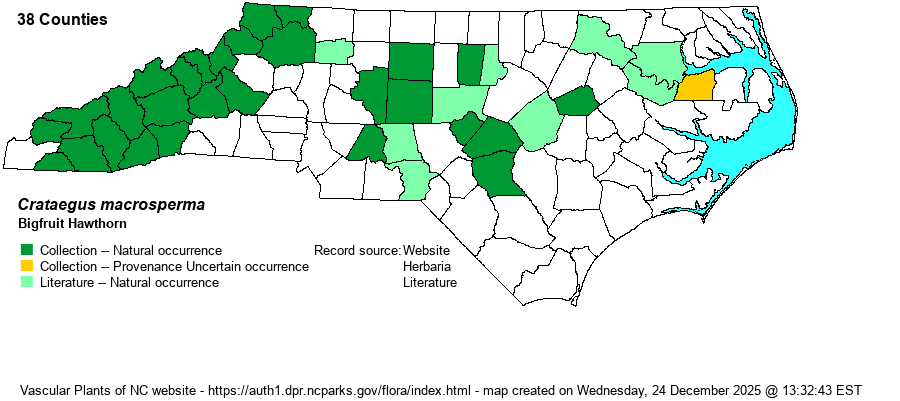| Author | Ashe | |
| Distribution | Despite the BONAP map indicating the species is present over much of the Coastal Plain, other references -- Lance (2014) and Weakley (2018) -- indicate that it is only found in the Mountains and Piedmont, though perhaps to the Fall Line. It likely occurs in most or all Mountain counties, but may be of spotty range in the Piedmont. Most records from the Coastal Plain might be best considered as uncertain provenance at the present time, though there is now a 2023 specimen (NCU) from Wilson County, and it does occur in the VA Coastal Plain. The map below is likely somewhat incomplete, as this is one of so many hawthorn species that have been recently described or recently split out from other species.
This is a wide-ranging Northern species ranging from PA and IL south to northern SC and northern MS.
| |
| Abundance | Fairly common to common in the Mountains. Uncommon in the Piedmont, but very rare to possibly absent in the Coastal Plain. Surprisingly, the NCNHP does not list the species in its database, and thus this website must provide a state rank; S4? seems to best represent the currently known situation. | |
| Habitat | This species has a wide array of dry to mesic habitats – upland forests, rocky woodlands, mesic to rich slopes, edges, and old pastures. It can at times occur in wetlands. |
| Phenology | Blooms from April to early May; fruits in September and October. | |
| Identification | This is a large shrub or small tree, with broadly ovate leaves. The leaves are strongly serrated, and may occasionally show side lobes. Distinguishing marks mentioned by Weakley (2018) include “adaxially scabrous young leaves, 5-10 stamens, and soft-textured mature fruit.” That is, the young leaves are rough/sandpapery on the upper surface. The fruit may also have some pale whitish bloom (i.e., pruinose) on the surface. You should not have problems encountering this species in the mountains, though you likely will need to collect or photograph a twig and leaves/flowers for keying out later. | |
| Taxonomic Comments | This is a relatively well-known species, though RAB (1968) included it within the very broad C. flabellata, which is no longer a valid species as it has been “doled out” into many other species now. Fortunately for most of us, neither Lance (2014) nor Weakley (2018) list any varieties of this species, despite it looking like many others to most biologists.
| |
| Other Common Name(s) | Eastern Hawthorn, Large-seeded Hawthorn. Lance (2014) says that the species does not have large seeds, and thus “macrosperma = large seed” is a misnomer. He suggests using Eastern Hawthorn, which has been adopted by Weakley (2018) and Flora of North America. However, dozens of species of hawthorns occur in the eastern US, and this name is thus not helpful. And, most current references and websites use a descriptive – though technically incorrect name -- “bigfruit”, “large-seeded”, etc. For now, this website will use a descriptive common name. | |
| State Rank | [S4?] * | |
| Global Rank | G5 | |
| State Status | | |
| US Status | | |
| USACE-agcp | | |
| USACE-emp | | |

